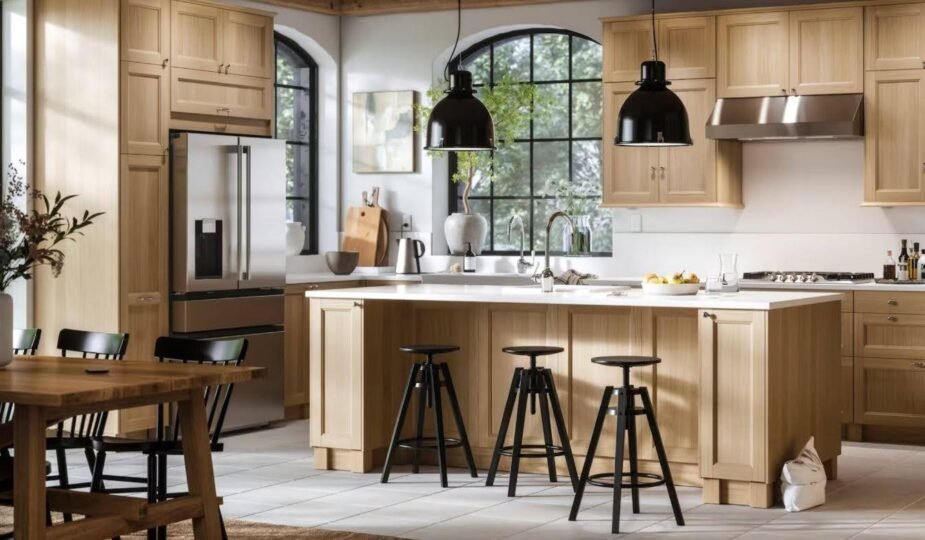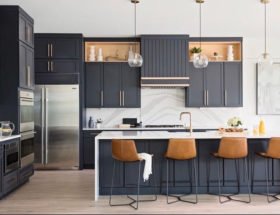Natural wood kitchen cabinets have been a timeless choice for homeowners seeking to combine beauty, durability, and eco-friendliness in their kitchen designs. With their unique grain patterns, warm tones, and versatile appeal, natural wood cabinets can transform any kitchen into a space that is both aesthetically pleasing and highly functional. In this article, we will explore the many advantages of natural wood kitchen cabinets, from their visual appeal and practical benefits to their sustainability. By the end, you’ll see why these cabinets are a popular choice for creating a kitchen that is as stunning as it is sustainable.
The Aesthetic Appeal of Natural Wood Kitchen Cabinets
Why Choose Natural Wood?
When it comes to kitchen design, natural wood cabinets stand out for their distinctive beauty. Each piece of wood used in cabinetry boasts unique grain patterns and textures, making every set of cabinets one-of-a-kind. This natural variation is what gives natural wood kitchen cabinets their character, allowing them to add warmth and richness to any kitchen space.
Natural wood is versatile enough to complement a wide range of kitchen styles, from rustic and farmhouse to modern and minimalist. Whether you prefer the light tones of maple or the deep hues of walnut, there’s a wood type that can enhance your kitchen’s aesthetic.
Types of Wood for Kitchen Cabinets
- Oak: Known for its durability and prominent grain pattern, oak is a popular choice for traditional and farmhouse-style kitchens.
- Maple: With a smooth, fine grain and light color, maple offers a clean, modern look that’s perfect for minimalist kitchens.
- Cherry: Cherry wood darkens over time, developing a rich, warm patina that adds depth and elegance to any kitchen.
- Walnut: Walnut’s deep, rich color and straight grain make it an excellent choice for luxurious, high-end kitchens.
Finishing Options
The finish you choose for your natural wood cabinets can greatly affect their appearance. Here are a few popular options:
- Stains: Enhance the natural grain of the wood while adding color. Light stains keep the wood’s natural look intact, while darker stains can add a touch of sophistication.
- Varnishes: Provide a protective layer that adds shine and durability to the wood surface, available in matte, satin, and glossy finishes.
- Paints: Although not as common for natural wood, paints can give a pop of color while allowing some of the wood’s texture to show through.

Functionality and Durability
Strengths of Natural Wood Cabinets
One of the primary reasons homeowners choose natural wood cabinets is their durability. Natural wood is strong and resilient, able to withstand the wear and tear of daily kitchen use. Unlike synthetic materials, wood can be easily repaired if damaged, making it a long-lasting option that can serve your kitchen for decades.
Maintenance Tips for Longevity
To ensure that your natural wood kitchen cabinets last as long as possible, regular maintenance is essential:
- Cleaning: Wipe down cabinets with a soft, damp cloth to remove dirt and grease. Avoid harsh chemicals that can damage the wood’s finish.
- Polishing: Use a wood polish or wax to maintain the cabinets’ shine and protect the finish from scratches.
- Preventing Damage: Use cabinet liners to protect the interior from spills, and avoid placing hot pots or pans directly on the wood surface.
Customization and Flexibility
Natural wood cabinets offer a high level of customization, allowing you to tailor your kitchen to your specific needs and preferences:
- Soft-Close Hinges: Prevent doors from slamming, reducing wear and tear.
- Adjustable Shelves: Provide flexible storage options that can be adapted as your needs change.
- Pull-Out Drawers: Make it easier to access items stored in lower cabinets, improving kitchen functionality.
Sustainability of Natural Wood Kitchen Cabinets
Eco-Friendly Sourcing
Sustainability is a significant consideration for modern homeowners, and natural wood kitchen cabinets excel in this area. The key to ensuring your cabinets are environmentally friendly is sourcing wood from responsibly managed forests. Look for certifications from organizations like the Forest Stewardship Council (FSC), which guarantees that the wood is harvested in a way that maintains the health of the forest and its ecosystem.
By choosing natural wood kitchen cabinets made from sustainably sourced wood, you are supporting forestry practices that prevent deforestation and promote biodiversity. This not only benefits the environment but also ensures that wood remains a renewable resource for future generations.
The Environmental Benefits
Natural wood is one of the most sustainable materials available for kitchen cabinets. It has a lower carbon footprint compared to synthetic materials, which often require significant energy and chemical processing. Additionally, wood acts as a carbon sink, storing carbon dioxide that would otherwise contribute to greenhouse gas emissions.
Here are some environmental benefits of natural wood cabinets:
- Renewability: Wood is a renewable resource that can be replanted and harvested sustainably.
- Biodegradability: Unlike synthetic materials, wood is biodegradable, reducing the impact on landfills.
- Energy Efficiency: The production of wood cabinets requires less energy than the manufacturing of metal or plastic alternatives.
End-of-Life Considerations
Another aspect of sustainability is what happens to the cabinets at the end of their life cycle. Natural wood cabinets can be easily recycled or repurposed, reducing waste. For example, old cabinets can be refinished and used in another room, or the wood can be reclaimed for other building projects. This flexibility in reuse further enhances the environmental credentials of natural wood kitchen cabinets.

Design Inspiration for Natural Wood Cabinets
Rustic and Farmhouse Kitchens
Natural wood cabinets are the perfect choice for creating a warm, inviting kitchen with a rustic or farmhouse style. The natural grain and texture of the wood bring an organic, earthy feel to the space, especially when paired with other natural materials like stone or brick.
Consider the following design elements for a rustic kitchen:
- Exposed Wood Beams: Complement the natural wood cabinets with exposed wooden beams on the ceiling.
- Natural Stone Countertops: Pair the cabinets with stone countertops for a cohesive, rustic look.
- Antique Hardware: Use vintage-style handles and knobs to enhance the farmhouse aesthetic.
Modern and Minimalist Kitchens
For those who prefer a sleek, contemporary look, natural wood cabinets can still be an excellent choice. Opt for light wood finishes, such as maple or ash, which provide a clean, minimalist appearance. The simplicity of natural wood works beautifully in modern kitchens, where less is more.
Design tips for a modern kitchen with natural wood cabinets:
- Neutral Color Palette: Combine light wood cabinets with neutral colors like white, gray, or black for a minimalist look.
- Minimal Hardware: Use simple, unobtrusive hardware to keep the focus on the natural beauty of the wood.
- Open Shelving: Consider integrating open shelving to break up the cabinetry and add a modern touch.
Traditional and Classic Kitchens
If you’re aiming for a more traditional or classic kitchen design, rich, dark wood tones like cherry or walnut are ideal. These woods add a sense of luxury and sophistication to the space, especially when paired with decorative details.
Ideas for a traditional kitchen with natural wood cabinets:
- Crown Molding: Add crown molding to the cabinets for an elegant, classic look.
- Glass-Front Cabinets: Incorporate glass-front cabinets to showcase fine china or decorative items.
- Intricate Woodwork: Consider detailed paneling or carved wood accents to enhance the traditional style.
Conclusion
Summarize Key Points
Natural wood kitchen cabinets offer a unique combination of beauty, functionality, and sustainability. They bring warmth and character to any kitchen while also providing the durability needed to withstand daily use. Moreover, by choosing sustainably sourced wood, homeowners can make an eco-friendly choice that supports responsible forestry practices.
Final Thoughts
Whether your style leans towards rustic charm, modern minimalism, or classic elegance, natural wood kitchen cabinets can be tailored to meet your design needs. Their versatility and timeless appeal make them a smart investment for anyone looking to create a kitchen that is both stylish and sustainable.









